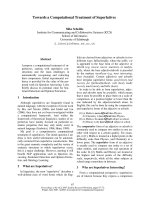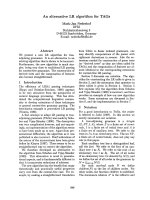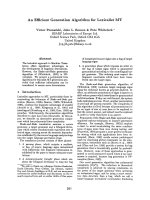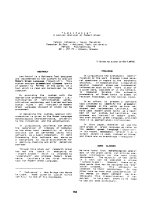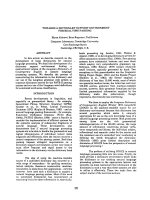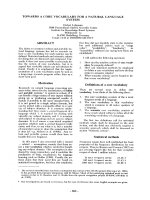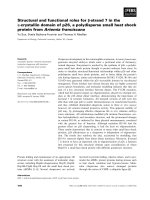Báo cáo khoa học: "Towards a feasible algorithm for tight glycaemic control in critically ill patients: a systematic review of the literature" pdf
Bạn đang xem bản rút gọn của tài liệu. Xem và tải ngay bản đầy đủ của tài liệu tại đây (134.03 KB, 7 trang )
Open Access
Available online />Page 1 of 7
(page number not for citation purposes)
Vol 10 No 1
Research
Towards a feasible algorithm for tight glycaemic control in
critically ill patients: a systematic review of the literature
Sofie Meijering
1
, Anouk M Corstjens
2
, Jaap E Tulleken
3
, John HJM Meertens
4
, Jan G Zijlstra
5
and
Jack JM Ligtenberg
6
1
Medical Doctor, Intensive & Respiratory Care Unit (ICB), University Medical Center Groningen, Groningen, The Netherlands
2
Anesthesiologist, Intensive & Respiratory Care Unit (ICB), University Medical Center Groningen, Groningen, The Netherlands
3
Internist-intensivist, Intensive & Respiratory Care Unit (ICB), University Medical Center Groningen, Groningen, The Netherlands
4
Anesthesiologist-intensivist, Intensive & Respiratory Care Unit (ICB), University Medical Center Groningen, Groningen, The Netherlands
5
Internist-intensivist, Intensive & Respiratory Care Unit (ICB), University Medical Center Groningen, Groningen, The Netherlands
6
Internist-intensivist, Intensive & Respiratory Care Unit (ICB), University Medical Center Groningen, Groningen, The Netherlands
Corresponding author: Jack JM Ligtenberg,
Received: 15 Jun 2005 Revisions requested: 29 Jul 2005 Revisions received: 22 Dec 2005 Accepted: 3 Jan 2006 Published: 26 Jan 2006
Critical Care 2006, 10:R19 (doi:10.1186/cc3981)
This article is online at: />© 2006 Meijering et al.; licensee BioMed Central Ltd.
This is an open access article distributed under the terms of the Creative Commons Attribution License ( />),
which permits unrestricted use, distribution, and reproduction in any medium, provided the original work is properly cited.
Abstract
Introduction Tight glycaemic control is an important issue in the
management of intensive care unit (ICU) patients. The
glycaemic goals described by Van Den Berghe and colleagues
in their landmark study of intensive insulin therapy appear
difficult to achieve in a real life ICU setting. Most clinicians and
nurses are concerned about a potentially increased frequency of
severe hypoglycaemic episodes with more stringent glycaemic
control. One of the steps we took before we implemented a
glucose regulation protocol was to review published trials
employing insulin/glucose algorithms in critically ill patients.
Methods We conducted a search of the PubMed, Embase and
Cochrane databases using the following terms: 'glucose',
'insulin', 'protocol', 'algorithm', 'nomogram', 'scheme', 'critically
ill' and 'intensive care'. Our search was limited to clinical trials
conducted in humans. The aim of the papers selected was
required to be glycaemic control in critically ill patients; the
blood glucose target was required to be 10 mmol/l or under (or
use of a protocol that resulted in a mean blood glucose = 10
mmol/l). The studies were categorized according to patient type,
desired range of blood glucose values, method of insulin
administration, frequency of blood glucose control, time taken to
achieve the desired range for glucose, proportion of patients
with glucose in the desired range, mean blood glucose and
frequency of hypoglycaemic episodes.
Results A total of twenty-four reports satisfied our inclusion
criteria. Most recent studies (nine) were conducted in an ICU;
nine others were conducted in a perioperative setting and six
were conducted in patients with acute myocardial infarction or
stroke. Studies conducted before 2001 did not include
normoglycaemia among their aims, which changed after
publication of the study by Van Den Berghe and coworkers in
2001; glycaemic goals became tighter, with a target range
between 4 and 8 mmol/l in most studies.
Conclusion Studies using a dynamic scale protocol combining
a tight glucose target and the last two blood glucose values to
determine the insulin infusion rate yielded the best results in
terms of glycaemic control and reported low frequencies of
hypoglycaemic episodes.
Introduction
Evidence is increasing that tight glycaemic control reduces
morbidity and mortality in critically ill patients [1-3]. The study
conducted by Van Den Berghe and coworkers in thoracosur-
gical intensive care unit (ICU) patients [1] yielded impressive
results; glycaemic control to a mean blood glucose of 5.7
mmol/l lowered morbidity and mortality by nearly 50%. Follow-
ing the publication of this trial in 2001, many attempts have
been made to achieve strict glycaemic control in ICU patients,
with varying and sometimes disappointing results. The glycae-
mic goals described by Van Den Berghe and coworkers
appear difficult to achieve in a real life ICU. Furthermore, most
clinicians and nurses are concerned about the potential for an
increased frequency of severe hypoglycaemic episodes. Here
GIK = glucose-insulin-potassium, ICU = intensive care unit.
Critical Care Vol 10 No 1 Meijering et al.
Page 2 of 7
(page number not for citation purposes)
Table 1
Summary of studies included in the present evaluation
Ref. (year) Number of
patients and
category
Blood glucose
target (mmol/l)
Method Used BG meter Frequency of
measurements
Hypoglycaemia
(mmol/l)
Results
(mmol/l)
[1] 765
Thoracosurgi
cal ICU
patients
4.4–6.1 Start at BG >6.1
mmol/l. Insulin ±
0.1–2 IU/hour
depending on last
two BG values.
Glucose infusion or
feeding
ICU based
ABL700
®
bloodgas/BG
analyzer.
Arterial blood
samples
1–4 hours 5.1% of
patients <2.2
Mean morning
BG 5.7 ±
1.1
[4] (2004) 27 Mixed ICU
patients
4–7 Bath IIP: insulin ±
0.5–4 IU/hour,
depending on last
two BG values
Accu Check
®
Advantage 2.
Mostly arterial
samples
1–2 hours Three BG
values <2.2
Median BG
6.6
[2] (2004) 800 Mixed ICU
patients
<7.7 Insulin sc. If two BG
values >11.1 mmol/
l: insulin iv, sliding
scale. Glucose
infusion/feeding
Finger stick
samples or
plasma BG
(Vitros
®
lab
analyzer)
Every 3 hours if
sc, hourly if iv
0.34% of
patients <2.2
Mean BG 7.2
70% of BG
<7.7
[5] (2001) 20 Critically ill
diabetic
patients
6.7 Insulin iv between -
1.5 and +1.5 IU/
hours depending on
last two BG values.
Glucose-potassium
infusions
OneTouch
®
II.
Capillary
samples
4 hours No BG <2.5 Mean BG 7.8
± 0.2
[6] (2004) 118
Cardiothoraci
c ICU
patients
5.5–7.7 Yale IIP. Insulin ±
0.5–10 IU,
depending on last
two BG values and
infusion rate
OneTouch
®
Surestep Flex
1 hour 0.2% of BG
<3.3
73% between
4.4 and 7.7
[7] (2004) 52 Medical ICU
patients
5.5–7.7 Yale IIP. Insulin ±
0.5–10 IU,
depending on last
two BG values and
infusion rate
OneTouch
®
Surestep Flex
1–4 hours 0.3% of BG
<3.3
66% between
4.4 and 7.7
[3] (2004) 50 Mixed ICU
patients
4.5–6.1 Insulin ± 0.5–2 IU/
hour, depending on
last two BG values.
Dextrose infusion or
feeding
Accu Check
®
Inform.
Capillary
samples
1–2 hours 4% of patients
<2.2
11.5 ± 3.7
hours/day
between 4.5
and 6.1
[8] (2004) 168
Cardiothoraci
c ICU
patients
4.4–8.3 Insulin 1–16 IU/hour
+ bolus, sliding
scale, depending
on last BG value
Accu Check
®
Inform.
Venous
samples
1–4 hours 7.1% of BG
<2.2
61% of BG
between 4.4
and 8.3
[9] (2003) 17 Diabetic
patients,
acute medical
diseases
6–7 GIK + bolus, insulin
1–4 IU/h, dynamic
scale, depending
on last BG value
Hemocue
®
meter.
Capillary
samples
1 hour Four times Mean BG
10.1
[10]
(2002)
37 Postsurgical
NIDDM
patients
19 patients sc, 18
patients iv, sliding
scale, 5% glucose
infusion
Glucometer
®
.
Capillary
samples
4 hours 5.6% of
patients in iv
group
sc mean: 7.2
± 1.2 iv
mean: 7.3±
1.1
[11]
(2004)
72
Cardiothoraci
c diabetic
patients
6.9–11.1 GIK protocol.
Continuous GIK
infusion + insulin
bolus if BG >15
mmol/l
? 1 hour Mean BG 7.7
± 0.2
[31]
(1996)
60 Surgical
NIDDM
patients
3.3–11.1 Insulin bolus if BG
>11.1 mmol/l.
Group 1: saline.
Group 2: glucose-
insulin. Group 3:
bolus every 2 hours
Capillary
samples
15 min No Mean BG <9
within all
groups
Available online />Page 3 of 7
(page number not for citation purposes)
[12]
(2002)
29 Diabetic
patients,
cardiac
surgery, 5
days
6.7–11.1 Start if BG >7.8 mol/
l. Sliding scale
Venous and
capillary
samples
Six
measurements
per day
0.2% of BG
<3.8
Mean BG 9.5
[13]
(1997)
595 Diabetic
patients,
cardiac
surgery
<11.1 l Portland protocol:
insulin depending
on last two BG
values and insulin
infusion rate
Glucometer 1–2 hourly Mean BG 9.7
[14]
(1987)
24 Diabetic
patients after
surgery
6.7–10 Insulin ± 0.5 IU/hour
depending on BG.
Bolus if BG >13.3
mol/l. 5% dextrose
infusion
Accu Check +
strips
2 hourly 1.4% of
measurement
s
Mean BG
between 6.7
and 10
[15]
(1988)
30 Diabetic
patients,
perioperative
5–10 Group 1: iv, every 4
hours ± 0.5 IU/
hour. Group 2: sc,
every 4 hours ± 2
IU/4 hours.
Glucose-potassium
infusion
Glucometer Hourly during
surgery, 4
hourly after
surgery
0.6% of
measurement
s <2.8 in iv
group
67% of iv
group
between 5.0
and 10;
40% in sc
group
[17]
(2002)
188 Patients,
during
cardiac
surgery
4.4–6.6 Start (2 IU/hour) with
BG >6.6 mmol/l.
Double infusion rate
until BG <6.6 mol/l.
? 20 min 12% of patients
with BG <3.8
In 23% of
patients BG
<8.3
[18]
(1994)
77 Diabetic
patients,
surgery
6.7–10 Insulin ± 0.5–1.0 U/
hr depending on
BG
Reflolux S
(+strips) and
Glucose
hexokinase
(lab)
4 hourly, hourly
during surgery
Two patients 62% of
patients BG
between 3.5
and 15.0
[19]
(2000)
24 Type 2
diabetic
patients,
acute
myocardial
infarction
8.3–11.0 Insulin ± 1–2 IU/h,
depending on BG
range.
Venous
samples.
Automatic
analyzer (lab)
30 min to 2
hours
Mean BG 6.9
± 0.8
[20]
(2002)
25 Diabetic
patients,
acute
coronary
syndromes
6.6–8.2 Insulin change by -1
to +3 IU/hour,
depending on BG
Beckman
®
glucose
analyzer II
1–3 hourly Four patients
with mild
hypoglycaemi
a
Mean 7.2 ±
1.7
[21]
(1999)
25 Patients,
acute stroke
(during 24
hours)
4–7 GIK: 500 ml glucose
10% + 16 U insulin
+ 20 mmol KCl;
100 ml/hour. ± 4 U
insulin/infusate,
depending on BG
BM Glycemic
strips
2 hourly One patient Mean BG of
68% of
patients <7
[22]
(1992)
29 Diabetic
patients,
acute
myocardial
infarction
4–8, to reach
within 4 hours
Sliding scale, more
insulin with left
ventricular failure
and bodyweight
>120 % of ideal
Capillary
samples
1–4 hourly 1.2% of BG <3 Mean BG 8.2
± 1.3
[23]
(1994)
158 Diabetic
patients,
acute
myocardial
infarction
7–10 >15 mmol/l; bolus iv.
Insulin ± 0.5–1 IU/
hour depending on
BG. Glucose
infusion
Venous
samples.
Reflolux II
1–2 hourly 17.7% of
patients with
BG <3.0
mmol/l
Mean BG 9.2
± 2.9 after
24 hours
[24]
(1991)
35 Diabetic
patients,
acute
myocardial
infarction
4–8 Sliding scale.
Dextrose 5%
infusion
Glucometer II
®
.
Capillary
samples
2–4 hourly Mean BG
10.3 ± 2.1
Studies mentioned in the table are arranged according to patient category. Intensive care patients at the top, followed by surgical patients, divided
in patients undergoing general surgery and patients undergoing cardiac surgery. The third category of patients consists of patients with an acute
myocardial infarction. BG, blood glucose; IIP, insulin infusion protocol; iv, intravenous; NIDDM, noninsulin-dependent diabetes mellitus; sc,
subcutaneous.
Table 1 (Continued)
Summary of studies included in the present evaluation
Critical Care Vol 10 No 1 Meijering et al.
Page 4 of 7
(page number not for citation purposes)
we review the results of clinical trials using insulin/glucose
algorithms in critically ill patients, focusing on the number of
blood glucose determinations in the desired range, mean
blood glucose and frequency of hypoglycaemic episodes. We
provide recommendations for a feasible and reliable insulin/
glucose algorithm.
Materials and methods
We performed a search of the PubMed, Embase and
Cochrane databases using the following terms: 'glucose',
'insulin', 'protocol', 'algorithm', 'nomogram', 'scheme', 'critically
ill' and 'intensive care'. Our search was limited to full papers of
clinical trials in humans. We used the following inclusion crite-
ria: glycaemic control in critically ill patients was the objective
of the study; the blood glucose target was 10 mmol/l or under
(or the protocol used resulted in a mean blood glucose = 10
mmol/l); and a clear description of the study protocol was
given. Studies with patients undergoing only minor surgery
were not included. Studies performed with an experimental
closed loop, although promising, were also excluded because
this system cannot yet be applied in clinical practice. Studies
employing glucose-insulin-potassium (GIK) protocols (origi-
nally not designed to achieve tight glycaemic control) were
included if they satisfied the inclusion criteria.
The abstracts and the abstracts of 'related papers' were eval-
uated by two researchers (SM and JJML); all papers that sat-
isfied the inclusion criteria were read carefully, and 24 reports
were ultimately included in our evaluation. They were catego-
rized according to patient type, desired range of blood glu-
cose values, method of insulin administration, frequency of
blood glucose control, time taken to achieve the desired range
for blood glucose, proportion patients with blood glucose in
the desired range, mean blood glucose and frequency of
hypoglycemia. The algorithms used can be divided into
whether they use 'sliding' or 'dynamic' scales. With a sliding
scale a predetermined amount of insulin is administered,
according to the range in which the actual blood glucose value
is. For example, every patient with a blood glucose between 5
and 8 mmol/l receives 1 unit of insulin every hour; every patient
with a blood glucose between 8 and 11 mmol/l receives 2
units per hour; and so on. In a dynamic scale the dosage of
insulin is changed by a certain amount, depending on the
range in which the blood glucose is. For example, if blood glu-
cose values are between 6 and 8 mmol/l the actual insulin infu-
sion rate is increased by 1 unit per hour, and if they are
between 8 and 10 mmol/l the actual insulin infusion rate is
increased by 2 units per hour.
We focused on the results of the group treated using the stud-
ied algorithm; the control group was not of interest to the
present evaluation.
Results
Number of reviewed studies
Twenty-four papers were judged suitable for inclusion
because they satisfied the predefined inclusion criteria (Table
1; also see the references list). Most recent studies (nine)
were performed in ICUs [1-9]; nine other studies took place in
a perioperative setting, mostly in patients with a history of dia-
betes mellitus [10-18]; and six studies were conducted in
patients with acute myocardial infarction or stroke [19-24].
Perioperative studies and studies in myocardial infarction
patients were generally of limited duration. Blood glucose tar-
gets exhibited wide variation. Before 2001 most studies did
not include normoglycaemia among their aims, which changed
after publication of the study by Van Den Berghe and cowork-
ers [1]; glycaemic goals became tighter, with a target range
between 4 and 8 mmol/l in most studies.
Methods of insulin administration
Insulin was administered in different ways: subcutaneously,
continuous intravenous infusion combined with intravenous
bolus injections, or insulin combined with glucose and potas-
sium (glucose-insulin-potassium [GIK] infusion).
Subcutaneous insulin
Three studies employed subcutaneous insulin injections. In a
limited study conducted in perioperative diabetic patients [15]
the target range (5–10 mmol/l) was achieved in only 40% of
patients. In another limited study (19 patients) [10], reasona-
ble control was achieved during a 48-hour postoperative
period (mean glucose 7.2 ± 1.2 mmol/l). Krinsley [2] adminis-
tered subcutaneous insulin to 800 mixed ICU patients but
switched the route of administration to intravenous in the event
of failure to achieve glycaemic control; a blood glucose level
below 7.7 mmol/l was achieved in 69% of patients. In conclu-
sion, only a few studies employed subcutaneous insulin ther-
apy alone. Subcutaneous therapy, followed by intravenous
insulin if needed, resulted in glycaemic control in only two-
thirds of ICU patients.
Continuous insulin infusion
Most study protocols used continuous intravenous insulin infu-
sion combined with intravenous bolus injections.
Sliding scale protocols
Most studies using a sliding scale protocol resulted in moder-
ate to disappointing regulation of blood glucose, despite
blood glucose measurements every 1–4 hours. In a study con-
ducted in diabetic patients undergoing cardiac surgery [12]
the mean blood glucose was 9.5 mmol/l; in another study con-
ducted in 29 diabetic patients with acute myocardial infarction
[22] the level was 8.2 mmol/l; and in a third study conducted
in 35 diabetic patients with acute myocardial infarction [24]
the level was 10.3 mmol/l compared with a target of 4–8
mmol/l.
Available online />Page 5 of 7
(page number not for citation purposes)
GIK protocols
An alternative way to administer insulin is in one solution with
glucose and potassium (for example, GIK infusion; also known
as GIPS). GIK protocols were originally not designed to
acheive tight glucose regulation; this might explain why the
results of GIK are variable in terms of glycaemic control.
In a study conducted in diabetic patients with acute medical
diseases [9] the target of 6–8 mmol/l was not achieved
despite hourly blood glucose measurements (mean blood glu-
cose 10.1 mmol/l). In a recent study employing short-term GIK
infusion and additional bolus insulin injections in patients
undergoing cardiac surgery [11], a mean blood glucose of 7.7
± 0.2 mmol/l was reached. In a GIK study conducted in acute
stroke patients [21], 24% of patients had BG values above the
target range of 4–7 mmol/l during the first 24 hours.
Dynamic scale protocols
In critically ill patients the best results are attained in studies
using a dynamic scale protocol. The most tight glycaemic con-
trol (normoglycaemia) was achieved by Van den Berghe and
coworkers [1] in 765 thoracosurgical patients; the mean
morning blood glucose was 5.7 mmol/l. Hypoglycaemia (<2.2
mmol//) was identified in 5% of patients. Recently, in a study
conducted in a mixed medical-surgical ICU population [3],
blood glucose levels were between 4.5 and 6.1 mmol/l for
11.5 hours per day, with a reduction in the incidence of severe
hypoglycaemia from 16% to 4% after implementation of the
study protocol. Unfortunately, the report provides no informa-
tion regarding the mean blood glucose. In a recent study con-
ducted in 27 mixed ICU patients [4] a median blood glucose
of 6.6 mmol/l was reported. Dazzi and coworkers [5] per-
formed a study in 20 critically ill diabetic patients; the mean
blood glucose was 7.8 mmol/l. The frequency of hypoglycae-
mia was low, with no blood glucose values below 2.5 mmol/l.
In general, these recent studies using a dynamic scale yielded
better results in terms of glycaemic control to predefined tar-
gets and a low frequency of hypoglycaemic episodes com-
pared with studies using sliding scale protocols. They all
combine a tight glucose target and the use of the last two
blood glucose values to determine the insulin infusion rate
[1,3-7]].
Methods of blood glucose determination
Most studies used handheld meters with strips for blood glu-
cose determination at the bedside. In the study by Van Den
Berghe and coworkers [1], an ICU-based blood gas/blood
glucose analyzer was used. In the evaluated studies blood glu-
cose was measured in arterial, venous, or capillary blood sam-
ples.
Discussion
Tight blood glucose control in critically ill patients can best be
achieved using a protocol with continuous insulin infusion
combined with frequent blood glucose determinations and the
use of the last two blood glucose values to determine the insu-
lin infusion rate. Although there is much concern about
hypoglycaemia, the frequency of severe hypoglycaemic epi-
sodes has been found to be less than 4–5%; in some studies
this was even lower than with protocols used in the control
groups.
Debate is ongoing regarding the desired BG target. In the real
life ICU any change in blood glucose level toward the normal
range with an insulin infusion protocol will probably improve
hospital survival and reduce morbidity both in surgical and in
medical ICU patients [1,2,25]. The mechanisms underlying the
effects of glucose toxicity or the possibility of beneficial effects
of insulin infusion per se remain to be unravelled [26,27]. At
present there is no strong evidence that regulation between 4
and 6 mmol/l is more beneficial then regulation between 6 and
8 mmol/l. Most studies apparently aimed for a somewhat
higher, probably more feasible, target. On the other hand,
ongoing trials such as the Portland protocol [28] have set
lower target ranges – between 4.4 and 6.6 mmol/l.
The advice given in the recent Surviving Sepsis Campaign
Guidelines [29] – specifically to maintain blood glucose level
below 8.3 mmol/l following initial stabilization – seems practi-
cal and safe in common clinical practice, but will not always
result in improvement of glucose regulation in every ICU. For
our medical ICU we calculated a mean blood glucose of all
patients admitted in 2000–2001 of 7.5 ± 2.9 mmol/l, which
was achieved with insulin administration prescribed at the phy-
sician's discretion [30]. To achieve an improvement in morbid-
ity and mortality, we must probably select a blood glucose
target lower than 7.5 mmol/l.
In most studies handheld meters with strips were used. The lit-
erature on point-of-care testing suggests that accuracy varies
with the different handheld meters. Because we found that an
ICU-based blood gas/blood glucose analyzer had the best
correlation coefficient with our gold standard (central clinical
laboratory measurement), we prefer using this device to hand-
held meters [28]. Furthermore, the studies evaluated here
used capillary, venous, or arterial blood for glucose determina-
tion. It is known that full blood glucose and plasma glucose val-
ues differ, and the same is true for arterial and venous blood
samples.
In summary, we can make the following recommendations
regarding the implementation of a feasible glucose regulation
protocol. First, choose a blood glucose target between 4 and
8 mmol/l. How 'low' depends on local possibilities (personnel,
workload, fast and accurate point-of-care blood glucose deter-
mination, among other factors) and on the prevailing mean
blood glucose level before starting a protocol. Second, it is
preferable to use a dynamic scale protocol with continuous
insulin infusion combined with frequent blood glucose deter-
Critical Care Vol 10 No 1 Meijering et al.
Page 6 of 7
(page number not for citation purposes)
minations (hourly to every four hours) and to use the last two
blood glucose values to determine the insulin infusion rate.
Feasible protocols can be found in the recent literature (Table
1; also see the references list). Third, tight regulation without
hypoglycaemia is probably easier to achieve if continuous
enteral feeding can be provided. Whether continuous glucose
infusion is necessary before enteral feeding is started is not
clear yet. Finally, frequent blood glucose determinations
impose increased nursing workload, and acceptance of the
protocol by nurses is very important for successful implemen-
tation. Training, education and subsequently feedback is nec-
essary to motivate ICU nurses [3,7].
Conclusion
Tight glycaemic control in critically ill patients can best be
achieved using a protocol involving continuous insulin infusion
combined with frequent blood glucose determinations (hourly
to 4 hourly) and the use of the last two blood glucose values
to determine the insulin infusion rate. The blood glucose target
to aim for must be between 4 and 8 mmol/l and depends on
local possiblities (personnel, fast and accurate point-of-care
blood glucose determination, among other factors) and on the
prevailing mean blood glucose level before starting a protocol.
Acceptance of the protocol by nurses is very important for suc-
cessful implementation.
Competing interests
The authors declare that they have no competing interests.
Authors' contributions
SM and JJML conducted the study, collected data, and drafted
the manuscript. AMC, JGZ, JET and JHJMM assisted in writing
the manuscript. All authors read and approved the final manu-
script.
References
1. van den Berghe G, Wouters P, Weekers F, Verwaest C, Bruyn-
inckx F, Schetz M, Vlasselaers D, Ferdinande P, Lauwers P, Bouil-
lon R: Intensive insulin therapy in the critically ill patients. N
Engl J Med 2001, 345:1359-1367.
2. Krinsley JS: Effect of an intensive glucose management proto-
col on the mortality of critically ill adult patients. Mayo Clin
Proc 2004, 79:992-1000.
3. Kanji S, Singh A, Tierney M, Meggison H, McIntyre L, Hebert PC:
Standardization of intravenous insulin therapy improves the
efficiency and safety of blood glucose control in critically ill
adults. Intensive Care Med 2004, 30:804-810.
4. Laver S, Preston S, Turner D, McKinstry C, Padkin A: Implement-
ing intensive insulin therapy: development and audit of the
Bath insulin protocol. Anaesth Intensive Care 2004,
32:311-316.
5. Dazzi D, Taddei F, Gavarini A, Uggeri E, Negro R, Pezzarossa A:
The control of blood glucose in the critical diabetic patient: a
neuro-fuzzy method. J Diabetes Complications 2001, 15:80-87.
6. Goldberg PA, Sakharova OV, Barrett PW, Falko LN, Roussel MG,
Bak L, Blake-Holmes D, Marieb NJ, Inzucchi SE: Improving glyc-
emic control in the cardiothoracic intensive care unit: clinical
experience in two hospital settings. J Cardiothorac Vasc
Anesth 2004, 18:690-697.
7. Goldberg PA, Siegel MD, Sherwin RS, Halickman JI, Lee M, Bailey
VA, Lee SL, Dziura JD, Inzucchi SE: Implementation of a safe
and effective insulin infusion protocol in a medical intensive
care unit. Diabetes Care 2004, 27:461-467.
8. Zimmerman CR, Mlynarek ME, Jordan JA, Rajda CA, Horst HM: An
insulin infusion protocol in critically ill cardiothoracic surgery
patients. Ann Pharmacother 2004, 38:1123-1129.
9. Bonnier M, Lonnroth P, Gudbjornsdottir S, Attvall S, Jansson PA:
Validation of a glucose-insulin-potassium infusion algorithm
in hospitalized diabetic patients. J Intern Med 2003,
253:189-193.
10. Gonzalez-Michaca L, Ahumada M, Ponce-de-Leon S: Insulin sub-
cutaneous application vs. continuous infusion for postopera-
tive blood glucose control in patients with non-insulin-
dependent diabetes mellitus. Arch Med Res 2002, 33:48-52.
11. Lazar HL, Chipkin SR, Fitzgerald CA, Bao Y, Cabral H, Apstein CS:
Tight glycemic control in diabetic coronary artery bypass graft
patients improves perioperative outcomes and decreases
recurrent ischemic events. Circulation 2004, 109:1497-1502.
12. Markovitz LJ, Wiechmann RJ, Harris N, Hayden V, Cooper J, John-
son G, Harelstad R, Calkins L, Braithwaite SS: Description and
evaluation of a glycemic management protocol for patients
with diabetes undergoing heart surgery. Endocr Pract 2002,
8:10-18.
13. Zerr KJ, Furnary AP, Grunkemeier GL, Bookin S, Kanhere V, Starr
A: Glucose control lowers the risk of wound infection in dia-
betics after open heart operations. Ann Thorac Surg 1997,
63:356-361.
14. Watts NB, Gebhart SS, Clark RV, Phillips LS: Postoperative
management of diabetes mellitus: steady-state glucose con-
trol with bedside algorithm for insulin adjustment. Diabetes
Care 1987, 10:722-728.
15. Pezzarossa A, Taddei F, Cimicchi MC, Rossini E, Contini S, Bon-
ora E, Gnudi A, Uggeri E: Perioperative management of diabetic
subjects. Subcutaneous versus intravenous insulin adminis-
tration during glucose-potassium infusion. Diabetes Care
1988, 11:52-58.
16. DeCherney GS, Maser RE, Lemole GM, Serra AJ, McNicholas
KW, Shapira N: Intravenous insulin infusion therapies for post-
operative coronary artery bypass graft patients. Del Med J
1998, 70:399-404.
17. Groban L, Butterworth J, Legault C, Rogers AT, Kon ND, Hammon
JW: Intraoperative insulin therapy does not reduce the need
for inotropic or antiarrhythmic therapy after cardiopulmonary
bypass. J Cardiothorac Vasc Anesth 2002, 16:405-412.
18. Jaspers CA, Elte JW, Olthof G: Perioperative diabetes regula-
tion with the help of a standard protocol. Neth J Med 1994,
44:122-130.
19. Melidonis A, Stefanidis A, Tournis S, Manoussakis S, Handanis S,
Zairis M, Dadiotis L, Foussas S: The role of strict metabolic con-
trol by insulin infusion on fibrinolytic profile during an acute
coronary event in diabetic patients. Clin Cardiol 2000,
23:160-164.
20. Stefanidis A, Melidonis A, Tournis S, Zairis M, Handanis S, Olym-
pios C, Asimacopoulos P, Foussas S: Intensive insulin treatment
Key messages
• Tight glycaemic control in critically ill patients can best
be achieved using a protocol with continuous insulin
infusion combined with frequent blood glucose determi-
nations and the use of the last two blood glucose values
to determine the insulin infusion rate.
• The blood glucose target must be between 4 and 8
mmol/l and depends on local possibilities (personnel,
fast and accurate point-of-care blood glucose determi-
nation, among other factors) and on the prevailing mean
blood glucose level before starting a protocol.
• Frequency of severe hypoglycaemia may even be lower
than with existing 'routine' protocols.
• Acceptance of the protocol by nurses is important for
successful implementation.
Available online />Page 7 of 7
(page number not for citation purposes)
reduces transient ischaemic episodes during acute coronary
events in diabetic patients. Acta Cardiol 2002, 57:357-364.
21. Scott JF, Robinson GM, French JM, O'Connell JE, Alberti KG, Gray
CS: Glucose potassium insulin infusions in the treatment of
acute stroke patients with mild to moderate hyperglycemia:
the Glucose Insulin in Stroke Trial (GIST). Stroke 1999,
30:793-799.
22. Hendra TJ, Yudkin JS: An algorithm for tight glycaemic control
in diabetic infarct survivors. Diabetes Res Clin Pract 1992,
16:213-220.
23. Malmberg KA, Efendic S, Ryden LE: Feasibility of insulin-glu-
cose infusion in diabetic patients with acute myocardial infarc-
tion. A report from the multicenter trial: DIGAMI. Diabetes Care
1994, 17:1007-1014.
24. Davies RR, Newton RW, McNeill GP, Fisher BM, Kesson CM,
Pearson D: Metabolic control in diabetic subjects following
myocardial infarction: difficulties in improving blood glucose
levels by intravenous insulin infusion. Scott Med J 1991,
36:74-76.
25. Furnary AP, Wu Y, Bookin SO: Effect of hyperglycemia and con-
tinuous intravenous insulin infusions on outcomes of cardiac
surgical procedures: the Portland Diabetic Project. Endocr
Pract 2004:21-33.
26. van den Berghe G: How does blood glucose control with insulin
save lives in intensive care? J Clin Invest 2004,
114:1187-1195.
27. Vanhorebeek I, Langouche L, van den Berghe G: Glycemic and
nonglycemic effects of insulin: how do they contribute to a bet-
ter outcome of critical illness? Curr Opin Crit Care 2005,
11:304-311.
28. Dellinger RP, Carlet JM, Masur H, Gerlach H, Calandra T, Cohen
J, Gea-Banacloche J, Keh D, Marshall JC, Parker MM, et al.: Sur-
viving Sepsis Campaign guidelines for management of severe
sepsis and septic shock. Intensive Care Med 2004,
30:536-555.
29. Ligtenberg JJ, Meijering S, Stienstra Y, Tulleken J, Nijsten MW,
Vogelzang M, Zijlstra JG: Mean glucose level is not an inde-
pendent risk factor for mortality in mixed ICU patients. Inten-
sive Care Med 2006 in press.
30. van der Horst IC, Spanjersberg R, Meijering S, de Wit H, Zijlstra
JG, Tulleken JE, Ligtenberg JJ: Accuracy of bedside bloodglu-
cose measurements in critically ill patients: a prospective
study. Int Care Med 2004, 30:S59.
31. Raucoules-Aime M, Labib Y, Levraut J, Gastaud P, Dolisi C,
Grimaud D: Use of i.v. insulin in well-controlled non-insulin-
dependent diabetics undergoing major surgery. Br J Anaesth
1996, 76:198-202.

